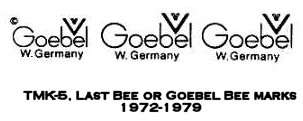Hummels Trademarks
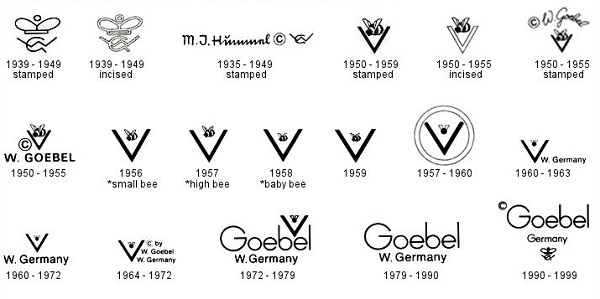
Have you ever looked at the bottom of a Hummel and wondered what the difference is between all the possible stamps? Well, I’ve been doing some research, and I’m ready to walk you through it! This might not be the most exciting thing I’ve ever shared with you, but if you’re a Hummel enthusiast, I hope it’ll be helpful.
Hummel trademarks can make a big difference in their pricing and there are a variety of reasons for that. The main factors for value are age and the number of pieces produced. Understanding each trademark can help you quickly identify what your collection is worth.
The first thing to know about Hummel’s trademarks is that if it doesn’t have one of these, it’s probably fake. Every so often, a rare undocumented trademark shows up, but the ones we’re about to discuss are the official Hummel trademarks.
Hummels Trademarks

Have you ever looked at the bottom of a Hummel and wondered what the difference is between all the possible stamps? Well, I’ve been doing some research, and I’m ready to walk you through it! This might not be the most exciting thing I’ve ever shared with you, but if you’re a Hummel enthusiast, I hope it’ll be helpful.
Hummel trademarks can make a big difference in their pricing and there are a variety of reasons for that. The main factors for value are age and the number of pieces produced. Understanding each trademark can help you quickly identify what your collection is worth.
The first thing to know about Hummel’s trademarks is that if it doesn’t have one of these, it’s probably fake. Every so often, a rare undocumented trademark shows up, but the ones we’re about to discuss are the official Hummel trademarks.
TMK-1 is used on the original Hummel figurines made from 1935 to 1949. This mark is sometimes found in an incised circle. Often referred to as the “Crown Marks” due to the inclusion of the crown image. The overlapping WG stands for Wilhelm Goebel, the founder of the Goebel Company, the producers of Hummels. The use of the crown signifies the company’s loyalty to the German royal family circa 1900, when the logo was first created.
TMK-1 is used on the original Hummel figurines made from 1935 to 1949. This mark is sometimes found in an incised circle. Often referred to as the “Crown Marks” due to the inclusion of the crown image. The overlapping WG stands for Wilhelm Goebel, the founder of the Goebel Company, the producers of Hummels. The use of the crown signifies the company’s loyalty to the German royal family circa 1900, when the logo was first created.
Trademark 2 (TMK-2)
TMK-2 is frequently known as the Full Bee, has as many as 12 variations, and was produced from 1950 – 1959. This mark may be incised, stamped in black or stamped in blue based on the exact date of creation. Earlier pieces were incised, and later pieces were stamped. The addition of the Bee paid homage to the artist behind Hummels, Berta Hummel, whose childhood nickname meant bumblebee. The bee was adjusted slightly throughout the years of its production, but all are considered Full Bee marks.
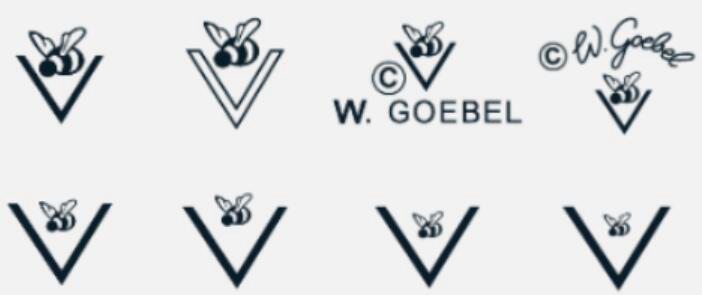
Trademark 2 (TMK-2)

TMK-2 is frequently known as the Full Bee, has as many as 12 variations, and was produced from 1950 – 1959. This mark may be incised, stamped in black or stamped in blue based on the exact date of creation. Earlier pieces were incised, and later pieces were stamped. The addition of the Bee paid homage to the artist behind Hummels, Berta Hummel, whose childhood nickname meant bumblebee. The bee was adjusted slightly throughout the years of its production, but all are considered Full Bee marks.
Trademark 3 (TMK-3) stylized the bee and was produced from 1960-1972. This mark is sometimes found in an incised circle. It is sometimes known as the One Line mark due to the line of text reading W. Germany.
TMK-3 stylized the bee and was produced from 1960-1972. This mark is sometimes found in an incised circle. It is sometimes known as the One Line mark due to the line of text reading W. Germany.
Trademark 4 (TMK-4)
TMK-4 was used simultaneously with TMK-3 beginning in 1964 and is also known as the Three Line mark due to the three lines of text next to the logo image. A new trademark was introduced in 1972, replacing TMK-4.

Trademark 4 (TMK-4)

TMK-4 was used simultaneously with TMK-3 beginning in 1964 and is also known as the Three Line mark due to the three lines of text next to the logo image. A new trademark was introduced in 1972, replacing TMK-4.
Trademark 6 (TMK-6)
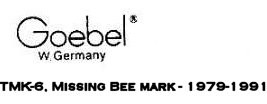
In 1979, the bee was removed from the logo, leading Trademark 6 (TMK-6) to be known as the Missing Bee mark.
Trademark 7 (TMK-7)
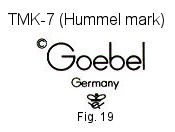
In 1990, the trademark was revised to reflect the reunification of Germany by adding the crown back to the logo. Trademark 7 (TMK-7) was used from 1990-2000.
Trademark 8 (TMK-8)
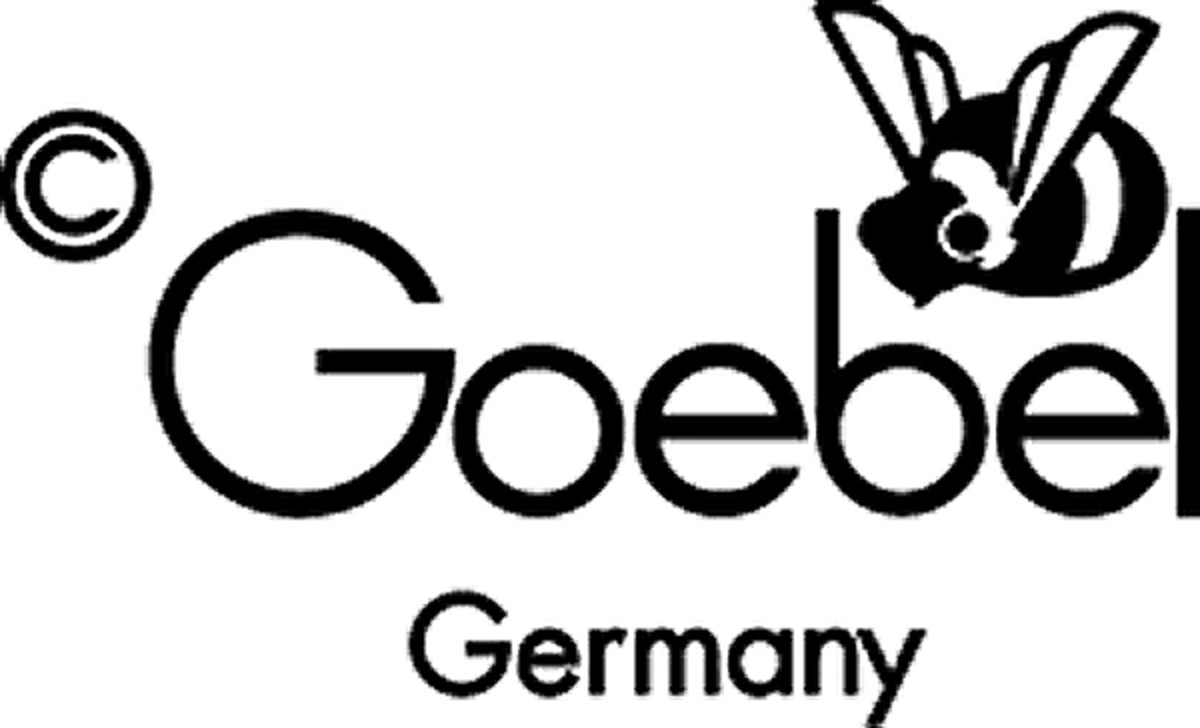
Trademark 8 (TMK-8) is the current trademark for Hummels and has been used since 2000. As you can see, the bee has been added back into the logo and is prominently featured.
Trademark 6 (TMK-6)

In 1979, the bee was removed from the logo, leading Trademark 6 (TMK-6) to be known as the Missing Bee mark.
Trademark 7 (TMK-7)

In 1990, the trademark was revised to reflect the reunification of Germany by adding the crown back to the logo. Trademark 7 (TMK-7) was used from 1990-2000.
Trademark 8 (TMK-8)

Trademark 8 (TMK-8) is the current trademark for Hummels and has been used since 2000. As you can see, the bee has been added back into the logo and is prominently featured.
If you’ve stuck with me this long, I’m glad you’re still here! I hope this was a helpful look at the different Goebel trademarks. If you’re looking to make sure your Hummels are authentic, look for any of the trademarks above. If you want to know how valuable your pieces are, generally, the older trademarks are the most valuable due to their age and increasing scarcity. The most valuable Hummels tend to be TMK-1, TMK-2, and TMK-3.
Due to the prolific nature of Maria Innocentia Hummel’s art, new Hummels are still being created based on her artwork, years after her death in 1946. Stick around because up next on the blog I’m sharing some of the most popular Hummel Designs.

If you’ve stuck with me this long, I’m glad you’re still here! I hope this was a helpful look at the different Goebel trademarks. If you’re looking to make sure your Hummels are authentic, look for any of the trademarks above. If you want to know how valuable your pieces are, generally, the older trademarks are the most valuable due to their age and increasing scarcity. The most valuable Hummels tend to be TMK-1, TMK-2, and TMK-3.
Due to the prolific nature of Maria Innocentia Hummel’s art, new Hummels are still being created based on her artwork, years after her death in 1946. Stick around because up next on the blog I’m sharing some of the most popular Hummel Designs.












